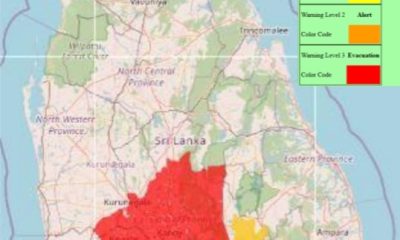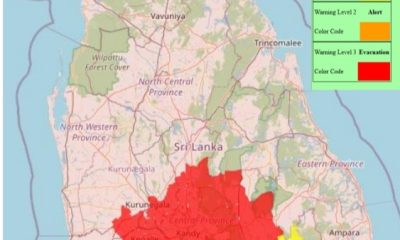Business
Operationally strong ComBank Group posts healthy topline growth, amidst prudent provisioning

The Commercial Bank of Ceylon Group has posted a strong operational performance in the first nine months as well as in the third quarter despite the continuing adverse effects of macroeconomic variables which have necessitated a tripling of impairment provisions for the nine months ended 30th September 2022 and reduced profits for the quarter as well as the year to date compared to the corresponding periods of last year.
Nevertheless, the Bank reported that the third quarter witnessed a reversal of the operating loss before Value Added Tax (VAT) on Financial Services of Rs. 3.581 billion reported for the second quarter of the year.These achievements were recorded even after providing relief for affected businesses and individuals in line with directions issued by the Central Bank of Sri Lanka as well as the Bank’s own relief schemes which included deferment of repayment terms of credit facilities, concessionary rates of interest on eligible loan products (debt moratorium) and waiving off certain fees and charges following the global pandemic, the Bank said.
Comprising of the Commercial Bank of Ceylon PLC, its subsidiaries and an associate, the Group reported gross income of Rs 195.573 billion for the first nine months of 2022 and Rs 76.056 billion for the third quarter, reflecting robust growth rates of 62.91% and 89.58% respectively in topline. Growth in loans and a noteworthy increase in income from interest-earning assets resulted in interest income for nine months improving by 56.15% to Rs 150.257 billion and by an even more impressive 89.04% to Rs 62.140 billion for the third quarter.
However, the growth in deposits in the review period combined with a sharp rise in interest rates and the consequent conversion of low-cost funds to high-cost funds saw interest expenses increasing by 79.58% to Rs 87.443 billion for the nine months, and by a whopping 142.71% to Rs 40.039 billion for the third quarter. The Bank’s CASA ratio, an industry benchmark, stood at 40.14% at the end of the nine months reviewed, as against 47.83% at end 2021 and 42.72% at end 2020. The increase in interest rates and the consequent reduction in the CASA ratio contributed to the higher interest expenses recorded in the period reviewed.
Nevertheless, net interest income for the nine months improved by 32.15% to Rs 62.814 billion, while net interest income for the third quarter increased by 34.97% to Rs 22.101 billion. With the escalation in interest expenses, net interest income accounted for 60.49% of the total operating income of the nine months reviewed, in contrast to 68.94% at the end of the third quarter of 2021.
Noting that the external challenges that have depressed profit and other indicators continued in the third quarter, Commercial Bank Chairman Prof. Ananda Jayawardane said: “The growth we have recorded in business volumes indicates that core banking operations remained intact. The single biggest impact on growth in terms of bottom line continues to be the burgeoning provisioning for impairment, which is an unavoidable response to the prevailing economic environment. Such provisioning assures our stakeholders that the Bank is financially prepared for any future contingencies.”
The Bank’s Managing Director and CEO Mr Sanath Manatunge commented: “Our results underline that at Commercial Bank, risk appetite and risk tolerance continue to be well-managed, especially in the context of the challenges faced by the banking sector. We have continued our focus on preserving the quality of the loan book, managing interest rates and liquidity, while improving compliance to minimize reputational risk. The increase in the cost of funds is inevitable, but all possible steps have been taken to increase the fee-based income and to maintain non-interest costs at acceptable levels.”
According to the Interim Financial Statements filed with the Colombo Stock Exchange (CSE), the Commercial Bank Group recorded a total operating income of Rs 103.837 billion for the nine months under review, an improvement of 50.59%. The figure for the third quarter was Rs 34.605 billion, reflecting an even stronger growth of 53.07%.
The net fee and commission income of the Group improved by 61.84% to Rs 13.913 billion for the nine months, while other income, which comprises of net gains from trading, net gains from derecognition of financial assets and net other operating income, grew by 111.45% to Rs 27.111 billion. Net gains from trading for the period amounted to Rs 34.124 billion compared to Rs 2.037 billion recorded for the corresponding period of the previous year. This was primarily from realized and unrealized gains from forward exchange contracts, spot and swap transactions and mark to market gains.
Impairment charges and provisions for other losses for the nine months amounted to Rs 52.272 billion, reflecting an increase of Rs 34.274 billion or 190.44% from Rs 17.997 billion recorded for the corresponding nine months of 2021. For the third quarter alone, impairment charges nearly quadrupled to Rs 17.053 billion from Rs 4.343 billion provided in respect of the third quarter of last year. Notably, a substantial portion of the impairment charges is on account of Government Securities denominated in Foreign Currency in view of the Sri Lankan Sovereign rating downgrade and the debt restructuring program currently being negotiated by the Government. Further, the exchange impact on impairment charges on loans and advances and Government Securities denominated in foreign currency was adjusted in Net Other Operating Income where the corresponding exchange gains are recognised. This was done in order to accurately reflect the underlying cost of risk and also to normalize the exchange gains and losses reported, the Bank said.
As a consequence of the increased impairment charges, net operating income for the nine months under review improved only by a marginal 1.20% to Rs 51.566 billion, while the figure of Rs 17.552 billion for the third quarter reflected a decline of 3.9%.
Operating expenses increased by 22.26% for the nine months to Rs 26.017 billion, and by 10.90% for the third quarter to Rs 7.985 billion, mainly due to the impact of inflationary pressures, Rupee deprecation and an increase in Government taxes. Consequently, personnel expenses increased by 20.40%, depreciation and amortization by 8.58% and other operating expenses by 30.59%. As a result, the Group’s operating profit before Value Added Tax on Financial Services reduced by 13.90% to Rs 25.549 billion for the nine months under review and by 13.53% to Rs 9.567 billion for the third quarter.
With VAT on Financial Services reducing by 23.81% to Rs 3.511 billion, the Group reported a profit before tax of Rs 22.036 billion for the nine months, recording a decline of 12.09% over the first nine months of 2021. Income tax for the period increased by 8.70% to Rs 6.576 billion despite the drop in pre-tax profit for the period under review as the figure for the corresponding nine months of 2021 was reduced by the reversal of an over-provision for 2020 resulting from the reduction in the corporate tax rate from 28% to 24%, which was adjusted in the first quarter of 2021.
Consequently, the Group’s profit after tax of Rs 15.460 billion for the nine months represented a decline of 18.70% compared to the corresponding period of last year. For the third quarter, the Commercial Bank Group reported a net profit of Rs 6.283 billion, a reduction of 5.72% compared to the same period of last year. Taken separately, Commercial Bank of Ceylon PLC posted a profit before tax of Rs 20.649 billion for the nine months, a drop of 15.46% while profit after tax for the third quarter was down 22.40% to Rs 14.438 billion.
Total assets of the Group grew by Rs 406.810 billion or 20.51% over the nine months to reach Rs 2.390 trillion as at 30th September 2022. Asset growth over the preceding 12 months was Rs 427.840 billion or 21.80%. A significant portion of the growth in assets during the period under review was due to the depreciation of the Sri Lankan Rupee against the US Dollar up to June 2022.
Gross loans and advances of the Group increased by Rs 147.574 billion or 13.48% to Rs 1.243 trillion as at 30th September 2022, while the growth of the loan book of the Group over the preceding year was Rs 175.451 billion or 16.44%.
Total deposits of the Group recorded a growth of Rs 380.829 billion or 25.86% in the nine months to Rs 1.853 trillion as at 30th September 2022, while the YOY deposit growth was Rs 405.581 billion or 28.01%. Here too, the Bank said the primary reason for the growth in gross loans and advances and deposits was the sharp depreciation of the Sri Lankan Rupee against the US Dollar in the first half of the year.
In other key indicators, the Bank’s net assets value per share increased by 14.16% to Rs 157.63 from Rs 138.08 as at end 2021. The Bank’s Tier 1 Capital Ratio, and the Total Capital Ratio stood at 11.571% and 14.355% respectively as at 30th September 2022, both above the statutory minimum ratios of 10% and 14% respectively. The Bank’s net interest margin improved to 3.80% for the nine months ended 30th September 2022, from 3.51% for the year 2021 and 3.37% for the nine months ended 30th September 2021. The Bank’s return on assets (before taxes) stood at 1.29% and return on equity at 10.72%.In terms of asset quality, the Bank’s impaired loans (stage 3) ratio stood at 4.09% compared to 3.85% at end 2021, while its stage 3 impairment to stage 3 loans ratio stood at 40.49% as at 30th September 2022, compared to 42.76% at end 2021.
The Bank’s Cost to Income Ratio before VAT on Financial Services improved to 24.94% for the period under review from 31.61% for 2021 and 33.95% for 2020. The cost to income ratio inclusive of VAT on Financial Services improved to 28.39% from 37.97% for 2021 and 39.96% for 2020.
Sri Lanka’s first 100% carbon neutral bank, the first Sri Lankan bank to be listed among the Top 1000 Banks of the World and the only Sri Lankan bank to be so listed for 12 years consecutively, Commercial Bank operates a network of 268 branches and 940 automated machines in Sri Lanka. Commercial Bank is the largest lender to Sri Lanka’s SME sector and is a leader in digital innovation in the country’s Banking sector. The Bank’s overseas operations encompass Bangladesh, where the Bank operates 19 outlets; Myanmar, where it has a Microfinance company in Nay Pyi Taw; and the Maldives, where the Bank has a fully-fledged Tier I Bank with a majority stake.
Business
Sri Lanka betting its tourism future on cold, hard numbers

National Airport Exit Survey tells quite a story
Australia’s role here is strategic, not charitable
In a quiet but significant shift, Sri Lanka’s tourism sector is moving beyond traditional destination marketing and instinct-based planning. The recent launch of the “From Data to Decisions” initiative jointly backed by Australia’s Market Development Facility and the Sri Lanka Tourism Development Authority, sent an unambiguous message: sentiment is out, statistics are in.
The initiative is anchored by a 12-month National Airport Exit Survey, a trove of data covering 16,000 travellers. The findings sketch a new traveller profile: nearly half are young (20–35), independent, and book online. Galle, Ella, and Sigiriya are the hotspots; women travellers outnumber men; and a promising 45% plan to return. This isn’t just trivia. It’s a strategic blueprint. If Sri Lanka Tourism listens, it can tailor everything from infrastructure to marketing, moving from guesswork to precision.
The keynote speaker, Deputy Minister Prof. Ruwan Ranasinghe called data “a vital pillar of tourism transformation.” Yet the unspoken truth is that Sri Lanka has long relied on generic appeals -beaches, heritage, smiles. In today’s crowded market, that’s no longer enough. As SLTDA Chairman Buddhika Hewawasam noted, this partnership is about “elevating how we collect, analyse, and use data.”
Australia’s role here is strategic, not charitable. By funding research and advocating for a Tourism Satellite Account, it is helping Sri Lanka build a tourism sector that is both sustainable and measurable. Australian High Commissioner Matthew Duckworth linked this support to “global standards of environmental protection” – a clear nod to the growing demand for green travel. This isn’t just aid; it’s influence through insight.
“The real test lies ahead,” a tourism expert told The Island. “Data is only as good as the decisions it drives. Will these insights overcome bureaucratic inertia? Will marketing budgets actually follow the evidence toward younger, independent, female travellers?,” he asked.
“The comprehensive report promised for early 2026 must move swiftly from recommendation to action. In an era where destinations are discovered on Instagram and planned with algorithms, intuition alone is a high-stakes gamble. This forum made one thing clear: Sri Lanka is finally building its future on what visitors actually do – not just what we hope they’ll do. The numbers are in. Now, the industry must dare to follow them,” he said.
By Sanath Nanayakkare
Business
New ATA Chair champions Asia’s small tea farmers, unveils ambitious agenda

In his inaugural address as the new Chairman of the Asia Tea Alliance (ATA), Nimal Udugampola placed the region’s millions of smallholders at the core of the global tea industry’s future, asserting they are the “indispensable engine” of a sector that produces over 90% of the world’s tea.
Udugampola, who is also Chairman of Sri Lanka’s Tea Smallholdings Development Authority, used his speech at the 6th ATA Summit held in Colombo on Nov. 27 to declare that the prosperity of Asian tea is “entirely contingent” on the resilience of its small-scale farmers, who have historically been overlooked by premium global markets.
“In Sri Lanka, smallholders account for over 75% of our national production. Across Asia, millions of families maintain the quality and character of our regional teas,” he stated, accepting the chairmanship for the 2025-2027 term.
To empower this vital community, Udugampola unveiled a vision focused on Sustainability, Equity, and Digital Transformation. The strategic agenda includes:
Climate Resilience: Promoting climate-smart agriculture and regenerative farming to protect smallholdings from environmental disruption.
Digital Equity: Leveraging technology like blockchain to create farm-to-cup traceability, connecting smallholders directly with premium consumers and ensuring fair value.
Market Expansion: Driving innovation in tea products and marketing to attract younger consumers and enter non-traditional markets.
Standard Harmonization: Establishing common regional quality and sustainability standards to protect the “Asian Tea” brand and push for stable, fair pricing.
Linking the alliance’s goals to national ambition, Udugampola highlighted Sri Lanka’s target of producing 400 million kilograms of tea by 2030. He presented the country’s “Pivithuru Tea Initiative” as a model for other ATA nations, designed to achieve this through smallholder empowerment, digitalization, and aligned policy objectives.
By Sanath Nanayakkare
Business
Brandix recognised as Green Brand of Year at SLIM Awards 2025

Brandix Apparel Solutions was recognised as the Green Brand of the Year at the Sri Lanka Institute of Marketing (SLIM) Brand Excellence Awards 2025, taking home Silver, the highest award presented in the category this year.
The ‘Green Brand of the Year’ recognises the brand that drives measurable environmental impact through sustainable practices, climate-aligned goals and long-term commitment to protecting natural resources.
A pioneer in responsible apparel manufacturing for over two decades, Brandix has championed best practices in the sphere of sustainable manufacturing covering environmental, social, and governance aspects. The company built the world’s first Net Zero Carbon-certified apparel manufacturing facility (across Scope 1 and Scope 2) and meets over 60% of its energy requirement in Sri Lanka via renewable sources.
Head of ESG at Brandix, Nirmal Perera, said: “Being recognised as Green Brand of the Year is an encouraging milestone for our teams working across sustainability.”
-
News5 days ago
Lunuwila tragedy not caused by those videoing Bell 212: SLAF
-

 News4 days ago
News4 days agoLevel III landslide early warning continue to be in force in the districts of Kandy, Kegalle, Kurunegala and Matale
-

 Latest News6 days ago
Latest News6 days agoLevel III landslide early warnings issued to the districts of Badulla, Kandy, Kegalle, Kurunegala, Matale and Nuwara-Eliya
-

 Features6 days ago
Features6 days agoDitwah: An unusual cyclone
-

 Latest News7 days ago
Latest News7 days agoUpdated Payment Instructions for Disaster Relief Contributions
-

 Business2 days ago
Business2 days agoLOLC Finance Factoring powers business growth
-

 News2 days ago
News2 days agoCPC delegation meets JVP for talks on disaster response
-

 News2 days ago
News2 days agoA 6th Year Accolade: The Eternal Opulence of My Fair Lady
























